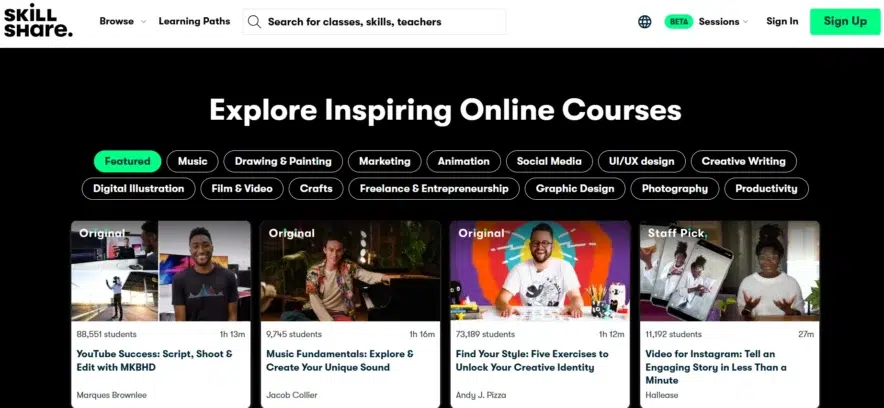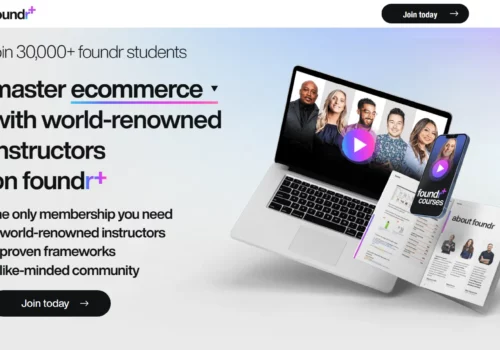Looking for Skillshare review, you are at the right place.
I’m always looking for new ways to boost my productivity and learn new skills. That’s why I was curious when I came across Skillshare, an online learning platform offering classes on everything from business and design to cooking.

I decided to try it out with their free trial. In this post, I’ll share my experience with Skillshare and let you know if I think it’s worth your time.

What is Skillshare, and what does it offer?
Skillshare is an online learning platform designed for people who want to grow their skills or explore new hobbies. It offers thousands of video-based classes across a wide range of topics, including business, creativity, technology, and personal development.
Whether you’re interested in learning graphic design, photography, marketing, coding, or even how to bake, Skillshare has something for everyone.
Industry experts and experienced creators teach the classes, and they’re usually broken into short, easy-to-follow lessons.
What’s great is that Skillshare is built for learners of all levels, so whether you’re a beginner or looking to refine an advanced skill, there’s plenty to explore.
Most classes also come with projects, so you can apply what you’ve learned right away.
My experience with Skillshare (Honest Review)
I’ve been using Skillshare for about a month now, and I really enjoy it! The courses are well-made and easy to follow, and I’ve learned a lot of new skills. I would definitely recommend it to anyone who is looking to improve their productivity or learn new skills.
So far, I’ve taken courses on time management, social media marketing, and graphic design. I’m really happy with the quality of the courses, and I feel like I’m learning a lot. The only downside is that some of the courses are a bit short, but overall, I’m really enjoying my experience with Skillshare.
If you’re looking for a way to improve your productivity or learn new skills, I recommend Skillshare.
How to get started with Skillshare?
Getting started with Skillshare is straightforward. First, you’ll need to create an account on their website or app. Skillshare often offers a free trial, so you can explore the platform before committing to a subscription.
Once you’ve signed up, choose a subscription plan if you decide to continue after the trial. From there, you can browse through thousands of classes by searching for topics that interest you, like design, business, or photography.
When you find a class you like, you can start watching the video lessons right away. Many classes include hands-on projects to help you practice what you’ve learned. Skillshare also lets you save classes and track your progress, making it easy to pick up where you left off.
It’s a flexible way to learn at your own pace, anytime and anywhere.
How to Cancel Skillshare?
Canceling a Skillshare subscription is simple and can be done in a few steps. Here’s how:
- Log In: Sign in to your Skillshare account on the website.
- Go to Account Settings: Click on your profile picture in the top-right corner and select “Settings” from the dropdown menu.
- Manage Subscription: Under the “Payments” section, look for the subscription details and click “Cancel Membership.”
- Confirm Cancellation: Follow the on-screen instructions to confirm. You may need to provide a reason for canceling.
Your subscription will remain active until the end of the current billing period. Remember to cancel before the next renewal date to avoid being charged again.
If you signed up through a third-party platform like Apple or Google, you’ll need to cancel via their respective app stores.
The pros and cons of Skillshare
Pros:
- Learn anything from design to cooking.
- Access all classes for one price.
- Learn at your own pace.
- Experts teach many classes.
- Hands-on learning with practical exercises.
Cons:
- Classes are available only with an active subscription.
- It’s not ideal if you need official certificates.
- Some classes are better than others.
- There are no strict deadlines or structured programs.
Final thoughts
Overall, I’m really happy with my experience on Skillshare and would recommend it to anyone who wants to boost their productivity or learn something new. The courses are well-designed, easy to follow, and have helped me pick up a lot of useful skills.
If you’re curious about Skillshare, I’d suggest trying the free trial to see if it’s right for you.
Thanks for reading this Skillshare review! If you have any questions, feel free to drop them in the comments, and I’ll gladly answer.






